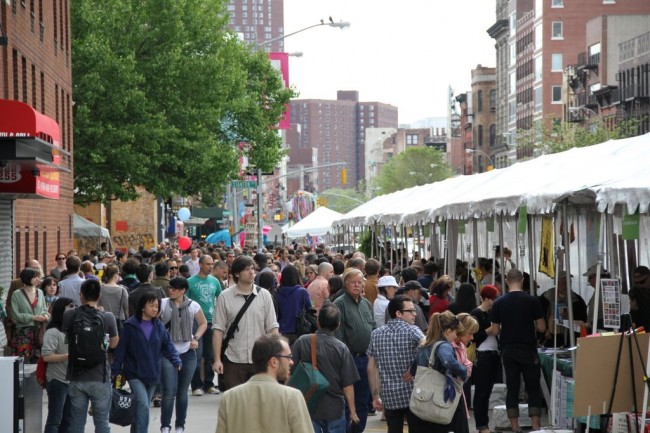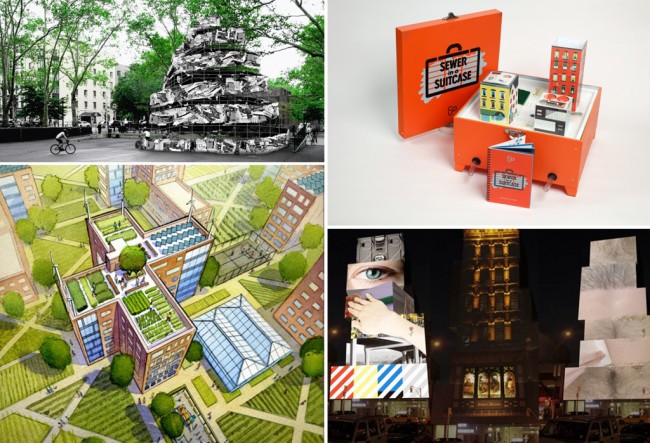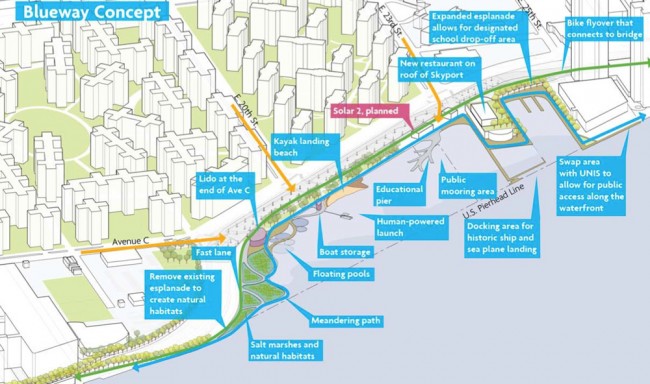
Celebrate ten years of Urban Omnibus and support ten more years of fresh, independent perspectives on citymaking with a donation today!
Celebrate ten years of Urban Omnibus and support ten more years of fresh, independent perspectives on citymaking with a donation today!

The 2011 StreetFest | Image via André-Pierre du Plessis
IDEAS CITY STREETFEST
The Omnibus team has been busy this week enjoying the many exceptional speakers, workshops, and events that make up this year’s IDEAS CITY Festival, a biennial exploration of the future of cities around the globe with the belief that arts and culture are essential to the vitality of urban centers, making them better places to live, work, and play. If you missed the two-day conference, videos of the talks and panel discussions are already available on the IDEAS CITY website. And luckily, there is still more festival to come. The IDEAS CITY StreetFest will take over Sara D. Roosevelt Park and the surrounding parts of the Lower East Side on Saturday from 11am-6pm and will showcase the work of architects, poets, technologists, historians, community activists, entrepreneurs, and ecologists, all of whom will be exploring this year’s theme of Untapped Capital.
Come visit us at the Architectural League of New York / Urban Omnibus tent at the corner of Chrystie and Stanton Streets, where we will be presenting a pop-up exhibition of photographs and information that outline the research agenda of Typecast, our new long-term investigation into building typologies — starting with towers-in-the-park. You will also be able to pick up a map of the outdoor library sites installed through the League and PEN World Voice Festival’s joint project Little Free Library/NYC. The designers of the book shelters will be constructing their installations at ten sites in Lower Manhattan on Saturday, and festival-goers are encouraged to visit the sites and meet the designers over the course of the afternoon.
Little Free Library/NYC and Typecast are just two of more than one hundred projects and installations planned for the StreetFest. You can sift through the complete list here, or take a look at a few highlights below:
• Terreform ONE will depict the false distinction between waste and supply in their sculpture Babel Waste Capital, representing an extension of the city constructed from its own trash.
• Trust Art, which may sound familiar if you caught our conversation with co-founder Jose Serrano-McClain, will bring together a network of artists whose work share the common thread of cooperation as they launch a funding platform for art projects jointly owned and controlled by active participants.
• Community Solutions and Alexander Gorlin Architects will propose public space improvements to invigorate housing developments, demonstrated through a masterplan for Brownsville, Brooklyn, at their booth in the exhibition Reimagining Housing Developments in Lower Manhattan.
• Check out prototypes of some of the winners in the City’s Reinvent Payphones design contest, launched to spark ideas of how to utilize the existing payphone infrastructure while adapting it for the future.

Clockwise from top left: Babel Waste Capital by Terreform ONE, Sewer in a Suitcase by CUP, Change of State by NBNY, and Brownsville Proposal by Alexander Gorlin Architects and Community Solutions | Images via IDEAS CITY
• The Center for Urban Pedagogy, the fine organization behind Fast-Tracked, the Predatory Equity Survival Guide, and Vendor Power, will showcase another one of their visually enticing tools developed to teach the complex systems of the city: Sewer in a Suitcase.
• Listen to and add your own stories to the collective history of the city with two oral history installations: StoryCorps’ walking tour Hear and There will guide you through the LES with selections from their archives, and SDR Coalition’s Oral History Booth will give you the opportunity to record your own impressions of the neighborhood and Sara D. Roosevelt Park.
• Stop by the Genspace NYC booth where the Brooklyn citizen science organization will lead two workshops on strawberry-DNA extraction and painting with bacteria.
• Share your ideas on how to improve the Lower East Side and see them displayed on an eight-foot interactive billboard installed by Neighborland, an online and street-level platform for sharing and organizing around local ideas for change.
• Research from three architecture courses at Columbia, Cooper Union, and Princeton dedicated to reimagining the Bowery will be on display in workshops and demonstrations throughout the afternoon.
• The Endangered Language Alliance will be on hand to record your language and language experiences (endangered language-speakers especially are encouraged to participate) at the Record-a-thon.
• Contribute to OpenUrban’s user-generated web map and wiki focusing on current and proposed urban development worldwide in their Map-a-thon.
• Join the Museum of the American Prison and founding members of the Civic Duty Initiative, a group of prisoners committed to giving back to their communities, for a discussion on how prisoners can contribute to solving current social problems. For more on the relationship between the justice system and the built environment, see our conversation with Laura Kurgan on redesigning Department of Probation waiting rooms into resource centers.
• Once the sun goes down, check out NightFest! The façade of the New Museum will be transformed through the projection of twelve designs by artists and architects in NBNY’s Change of State, an hour-long program starting on the hour and running from 8pm to midnight; art/architecture/performance collaborative Snarkitecture will present a 90-minute performance involving a roll-out of 25 illuminated spheres; Double One Design will build a light installation out of traffic control and construction safety materials; and Skate Truck NYC will set up a mini roller rink on Mulberry Street. Or head to the Old School from 6pm to midnight for SCHOOL NITE: a series of exhibitions bound by the theme “Wish Meme” that will explore “ideas of wish fulfillment, fiscal dependency, self-entitlement, and the agents working against these phenomena, which accounts for the push-and-pull within a generation raised in an economic bubble, and growing up or old through its sizable burst.”

The East River Blueway Plan’s components | Image via Curbed
EAST RIVER BLUEWAY PLAN
Last night, in a program hosted by the Cooper Union, Manhattan Borough President Scott Stringer and Assemblyman Brian Kavanagh released the final version of the East River Blueway Plan. The plan, which we discussed here on UO in an interview last May with Adam Lubinsky of WXY Architecture + Urban Design (one of the plan’s designers), calls for a series of kayak launches, beaches, pedestrian bridges, and wetlands to provide public access to the East River from as far north as 34th Street to underneath the Brooklyn Bridge while mitigating future storm surges. For more information about the plan and to check out updated renderings, see coverage on Curbed, DNAinfo, and Crain’s.
UNDER THE ELEVATED
The Design Trust for Public Space has announced its next major research/design/planning initiative, Under the Elevated. The project will produce design guidelines, programming, and policy recommendations that “maximize the function, use and spatial qualities of the millions of square feet of space underneath New York’s bridges, elevated highways, subways and rail lines.” The Design Trust is seeking three fellows for the project — in urban design, policy, and graphic design — as well as a photographer for the 2013 Photo Urbanism Fellowship, which will also focus on “life under and around elevated infrastructure in New York City.” The application deadline for all four fellowships is May 23, 2013.
SANDY: SIX MONTHS AFTER
Half a year after Hurricane Sandy initially displaced thousands of New Yorkers from their homes, many families are still looking for permanent housing. The 488 families who have jumped from evacuation shelters to hotel rooms funded by federal aid since the storm will have another month on the hotel shelter plan, an extension from the plan’s original end date of April 30. Their lack of options stand as a testament to the need for better planning to address the needs of low-income populations in future disasters.
The extent and quality of rebuilding from the storm at this point varies widely, as only about 16% of federal aid funds have been approved for particular projects, not all of which has actually made it to the end user. Although the federal government also approved New York State’s application for $1.7 billion in community block grants, $838 million of which would go to housing rehabilitation, the City calls the amount earmarked far from adequate, leaving many homeowners to rebuild but without the changes necessary to mitigate future storm damage.
In addition to rebuilding housing infrastructure, repairs to other systems continue. Water treatment plants, sited near the water by design and tasked with handling wastewater as well as stormwater thanks to the city’s outmoded combined sewer system, were particularly hard hit in the storm: an estimated 10 billion tons of sewage overflowed into waterways, streets, and homes in New York and New Jersey. Questions also remain about the future of communications infrastructure, all but knocked out by the storm, at a time when many people have abandoned landlines for cellphones that proved unreliable in the hardest hit areas.
Amidst the hardship, the last six months have also been full of stories like IceStone’s, a factory in the Brooklyn Navy Yard that, through the combined efforts and human capital of its workers, has landed back on its feet after every one of its 70 motors and 5,000 electrical relays had been submerged under five feet of water.
The Roundup keeps you up to date with topics we’ve featured and other things we think are worth knowing about.
The views expressed here are those of the authors only and do not reflect the position of The Architectural League of New York.